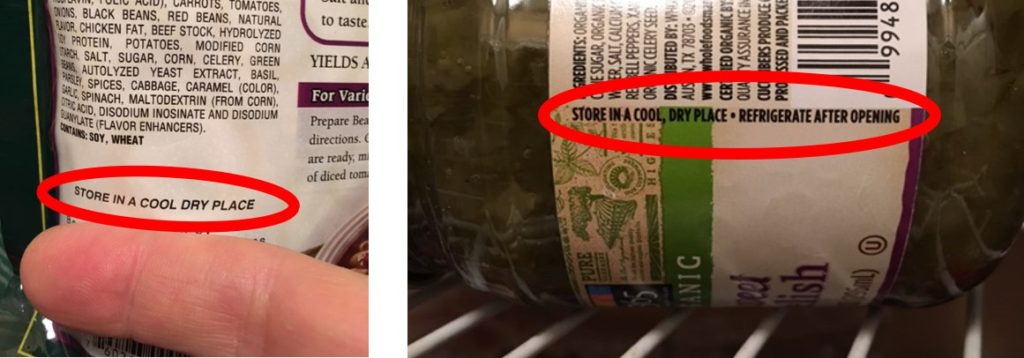FOOD SAFETY ALERT: “A cool and dry place”— So what exactly does that mean?
Have you ever read the labels of cans or jars that you buy from the store?
Though less than before, it used to be common place to read “Store in a cool and dry place” on the back labels of canned food items, regardless of whether they were in metal tins or in glass jars.
And so, we’ve grown accustomed to not even giving it much thought as we reach into our grocery bag and casually, routinely, place our newly purchased canned item(s) onto our pantry or cupboard shelf/ves.

But…
WHAT EXACTLY DOES THAT MEAN ?
And…
WHY SHOULD WE BE GIVING MORE THOUGHT to it than we ever have before ?
While these final instructions to “store in a cool, dry place” might be casually regarded as almost an after-thought….
…you know, because having canned goods is now so common place that we just naturally assume that we can keep them indefinitely (or almost) and transport them wherever and however we need to…
…there is a change happening that I’m quite certain many people have NOT given much thought to with regard to their pantries, but that should now require some extra thought and attention.
I mean, have YOU ever really had one of those moments when, as you read over the back label, you actually gave some serious thought about what the instructions really meant ?
Read The Back Label
Over the past several decades, especially since I had children, it has occurred to me, more than once, to read the back label and check for any special instructions.
And while I’m noticing that far fewer canned and jarred goods actually have those instructions now, we should still be taking a moment or so to really make sure that we understand what the instructions that are listed really mean.
And although this little bit of instruction no longer appears on a lot of canned goods, we should still be considering the factors that affect the safe long-term storage of our canned food items.
Labeling Practices Actually Getting Worse
Now, I could get into a whole discourse about labeling practices (which in many instances were a lot more diligent some 20, 25 and 30 or more years ago than they are today—-because for as much as we’ve made progress in this area, we’ve regressed just as much), but that would take me way off topic.
Just to tell you how much things have changed, the “Store in a cool, dry place” used to actually read, in most instances, “Store in a cool, dark and dry place” and used to be on ALL canned goods.
So, we need to be aware that just because these instructions are not on the label, that it does NOT mean that canned goods are impervious to external conditions (more on this a little later).
A Closer Look
For the moment, though, I just want us to look at the specific instructions
“Store in a cool, dry place”
and consider what they actually mean.
Well “dry”—- now, that’s obvious.
BUT what EXACTLY do they mean by “cool” ?
When I see the cans on the grocery store shelves, out there in the middle of the store, and then I bring them home and put them on my pantry or my cupboard shelves, where exactly does the “cool” part fit into that picture ?
It also seems to me that these general instructions are too open to interpretation.
There are indeed food products that, although heat and pressure canned, still require adequately “cool” and sometimes even refrigerated storage. I get that, especially when I see them at the store in the refrigerator section. Then it’s an obvious “okay, when I get home, then this goes into my fridge.”
But now, and I do mean NOW —- as in 2018, 2019 and for years to come —- it seems to me that we should be giving some extra thought and care to where and how we’re actually storing our canned goods.
That includes for products like Kettle & Fire‘s bone broth and other canned food products (pressure-canned, vacuum-packed or otherwise) that are pantry shelf-stable and that have a long shelf-life.
Now, Kettle & Fire says that their product is “shelf-safe for two years”.
But I would add “up to” in there also, because just like any other product, it is subject to external factors.
Factors That Influence Food Storage and Safety
External factors that influence the shelf-life and stability of canned and dry goods include:
- Light/Darkness (though not Kettle & Fire’s product because of it’s special packaging)
- Moisture/dryness (again, not Kettle & Fire’s product because of it’s special packaging)
- Heat/Cold
- Elevation (Air Pressure)
And the factor that I’m mainly concerned with in this post is the factor of temperature.
I speak from experience here as I’ve lived in cold, temperate and hot climes, dry and humid, as well as in air-conditioned and non-air-conditioned homes.
Rising Global Temperatures
And now with increasing temperatures even in areas that used to be more temperate, we are seeing warmer temperatures than what would be classified as ‘normal’.
This, then, becomes another factor that we need to keep in mind when we’re storing food items that come with label instructions to be kept in “cool” dry places.
Because just think…
So how cool is “cool” actually ?
When our “cool” place starts hitting temperatures above 70 degrees Fahrenheit (21 degrees Celsius) and stays that way for weeks on end during long, hot summer months…
Even temperatures of 72 and 73 degrees can start to feel too warm in the house. And if even these ‘low’ temperatures can start making butter soften when left on kitchen counters…
…and melt as the temperature approaches 80 degrees or hotter in warm, un-air-conditioned fan-cooled (or worse yet, non-cooled) kitchens…
…then, we need to be thinking about the dry and canned food items in our cupboards and pantries that are also experiencing this rise in temperature.
As a result of this, the shelf-life of all of our canned goods, including our pressure canned food items will undoubtedly be affected.
HOW ?
Just as food spoils more quickly when not refrigerated, so too do canned goods spoil more quickly when the storage temperature is not optimal.
And therefore, with rising temperatures, and extended exposure to warmer storage room/cupboard/pantry temperatures, we need to keep in mind that the shelf-life of our canned goods will be shortened and with it, greater probability of bacterial growth within their containers near the end of the projected shelf-life.
Because at some point, unless laced with chemical preservatives, canned goods WILL go bad.
And warmer storage temperatures will cause that to happen MORE QUICKLY.
Because warmer temperatures encourage bacterial growth.
(Now this is, by no means, an endorsement for chemical preservatives in our canned food items —- not at all.
This is simply a HEADS UP ALERT for what to expect and keep in mind with our food supplies as this global warming trend continues.)
Better Home Food Management Practices
What it means now is that we need to better manage our stored canned goods and use them in a more timely way than we currently do so we can avoid spoilage and waste.
And so, regardless of the printed expiration date on the bottom of the can or container, we can anticipate that that date will move closer by at least 1.5x or 2x the number of days or weeks that those cans/jars are left at above 70 degrees Fahrenheit (21 degrees Celsius) warmer temperatures.
In anticipation of shorter-than-projected shelf-life estimates, based on this temperature influence, we will be able to minimize our risks of getting sick from canned goods that have gone bad before their estimated expiration dates.
We just need to remember:
The higher the temperature above 70F (21C),
+ the longer the time span in these warmer temperatures,
=> the shorter the shelf-life and
=> the greater the risk of bacterial growth.
With this in mind, then, you may want to consider the following suggestions:
- check your home pantry air vents or ducts to ensure that no warm air or heat is entering in (at least in the winter) and that cool air flows through the vents during warmer months, and/or that
- try to maintain slightly cooler temperatures in your pantry (if possible, with its’ own temperature controls) even when summer temperatures might make your home warmer than usual, or
- if you have a below-ground basement (less common now with homes being built on slab foundations), consider building an insulated cold storage room, or
- consider investing in an extra refrigerator as a “cold storage” unit for all of your canned goods…
…all as means of guarding against warming temperature increases.
I hope that this extra consideration helps you now and in the coming years.
It’s just something that I thought you should be aware of both for your own safety and well-being as well as your family’s.
Be safe.
Keep well.
Stay healthy.
God bless.
Now, let me share with you the alternative-to-pressure-canning method that I use to safely and effectively ‘preserve’ Bone Broth. Click here now…
If you found this post helpful, please feel free to leave me your comments. I’d appreciate them. This post may be liked and shared from the first part of this post. Again, it’s much appreciated.

